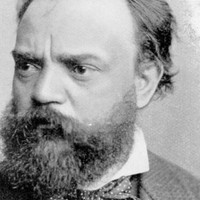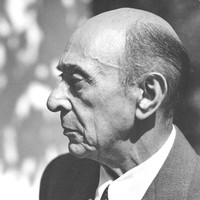Beethoven’s Pastoral Symphony
Sponsored By
- September 13, 2013

- September 14, 2013

Sponsored By



(Duration: 27 min)
Antonín Dvořák grew up in a small Bohemian village where his father ran an inn and entertained guests by playing the region’s quintessential folk instrument, the zither. After Dvořák moved to Prague to pursue a career in music, he scraped by any way he could — teaching piano, playing church organ, and gigging with a dance band on the viola, to name a few of the activities that supported his composing. He might have spent the rest of his life in obscurity had it not been for the intervention of a most influential champion, Johannes Brahms, who discovered the young Czech composer when judging a competition.
One work that Dvořák submitted for that competition was the Serenade for Strings that he had composed over twelve days in May of 1875. Brahms was so impressed that he forwarded a stack of scores on to his publisher, who soon commissioned Dvořák’s Slavonic Dances and launched his international career.
To composers in Wolfgang Amadeus Mozart’s era, the Serenade was a form of simple entertainment to be performed outdoors at public gatherings in the evening. By the nineteenth century, composers applied the term more generally to pieces of a pleasing, “night-music” character with a loose assemblage of movements, a format that suited Dvořák’s gift for melodic invention.
Most of the movements of the Serenade for Strings follow a three-part structure, with statements of a primary theme (or group of themes) separated by a contrasting middle section. The opening Moderato demonstrates this simple elegance, forgoing an introduction and developmental transitions, and instead moving without delay from one memorable melody to the next. Singable themes continue to unfurl in the Waltz, Scherzo and Larghetto, the last of which provides a rich and sentimental departure from the Serenade’s cheery disposition. In the Finale, playful quotations help to bring the work full circle.
Aaron Grad ©2024

Please note: movements performed without pause.
Arnold Schoenberg is most famous — or perhaps infamous — for pioneering atonality and the twelve-tone method of composition. Despite all the “accusations of anarchy and revolution” directed his way over the years, his own view (as he explained in a 1949 lecture) was that his development as a composer “was distinctly evolution, no more exorbitant than that which always has occurred in the history of music.”
In that sense, Schoenberg’s First Chamber Symphony from 1906 is a key link in the ongoing evolution that began when Ludwig van Beethoven unshackled the symphony and string quartet from their tidy confines about a hundred years earlier, a process that continued down one lineage through the taut manipulations of Johannes Brahms, while a parallel lineage led by Richard Wagner, Franz Liszt and Richard Strauss sought the outer limits of the tonal universe.
Schoenberg’s chamber symphony compresses a plan resembling the traditional movements of a symphony into one continuous movement lasting about 20 minutes, moving through sections that he identified as Sonata (Allegro), Scherzo, Development, Adagio, and Recapitulation and Finale. In terms of instrumentation, this score shrinks the expected orchestral forces down to a chamber group of fifteen soloists, but the standard colors of the Classical symphony are still there, with one of each stringed instrument, eight woodwinds and two horns.
In a feat of musical efficiency that recalls Beethoven’s ability to zoom in on a basic gesture, much of Schoenberg’s music concentrates on two basic gestures: chains of perfect fourths (as in the distance between the first two notes in “Here Comes the Bride”), and the whole-tone series, built from equally spaced whole steps. Besides shaping the melodies, those patterns of fourths and whole-tones also stack up vertically, replacing traditional triads as the building blocks for chords.
The First Chamber Symphony was one of Schoenberg’s last works that functioned fully within the realm of tonal harmony, even ending on a sunny major triad. But for all its traditionalism, the sharp elbows of this music revealed an approach its breaking point. As the conductor and Schoenberg expert Robert Craft put it, the chamber symphony was “the densest, most compact and rapidly moving music up to its time,” and it marked a turning point into a different sort of unknown in the years to come.
Aaron Grad ©2022
 Watch Video
Watch Video
The Sixth Symphony comes from the heart of Ludwig van Beethoven’s “middle” period, a phase when his encroaching deafness changed his relationship to composing and performing, and when the crystalline classicism of his early works gave way to a more focused and concentrated manner of writing. Rather than issuing flowing melodies, Beethoven’s quintessential works from this period build highly integrated forms out of compact, elemental materials.
The most iconic symphony from the “middle” period is Beethoven’s Fifth, but the same single-minded focus shows up in another work that was on his writing desk at the same time in 1808, the Sixth Symphony. The ingredient that made this work unlike any previous symphonies of Beethoven (or anyone else) was the extent to which storytelling was embedded within the formal structure. For the initial performance in 1808, Beethoven acknowledged the external inspiration in his full title: “Pastoral Symphony, or Recollections of Country Life: More an Expression of Feeling than Painting.”
Beethoven’s journals and letters reveal his love of nature, as when he wrote in 1810, “How delighted I will be to ramble for a while through the bushes, woods, under trees, through grass, and around rocks. No one can love the country as much as I do. For surely woods, trees, and rocks produce the echo that man desires to hear.” Recognizing and appreciating the natural world was a cornerstone of the Romantic ethos, and Beethoven’s Pastoral Symphony joined a common thread in music, art and literature of the early nineteenth century that rhapsodized on the beauty and grandeur of the natural world, with a reverence that was in no small part spiritual.
Just as the first four notes of the Fifth Symphony influence every measure of the opening movement, the Sixth Symphony builds an expansive essay out of a seemingly naïve theme. The first movement, characterized as the “Awakening of cheerful feelings upon arrival in the country,” enters bashfully, with four quiet measures that trail off. Fragments of this figure build slowly, basking in long stretches of unmoving harmony. The development section, often an opportunity for increased turbulence and activity, instead sinks deeper into a country calm, savoring each radiant chord change.
The second movement, “Scene at the Brook,” establishes a lapping triplet pulse under another mere wisp of melody. The idyllic scene ends with a trio of birdcalls from the woodwinds, representing a nightingale, quail and cuckoo. From here, the symphony diverges from a typical four-movement pattern. There is a Scherzo-like third movement, “Happy gathering of country folk,” but the rollicking dance music halts unresolved and is supplanted by the first staccato raindrops of the “Thunderstorm.” Fearful dissonances and thunderous timpani strikes make for a convincing tempest, until it trails off in one last upward patter from the flute. A clarinet takes over to establish the sing-song contours of the “Shepherds’ song; cheerful and thankful feelings after the storm.” This tune, at once humble and heroic, returns the symphony to its pastoral calm. Near the end, a hymn-like variant lends a deeper resonance to this sunny conclusion.
Aaron Grad ©2023
Get driving directions and find nearby parking.
Find dining options close to the venue.
View seating charts to find out where you'll be seating.
Get driving directions and find nearby parking.
Find dining options close to the venue.
View seating charts to find out where you'll be seating.
